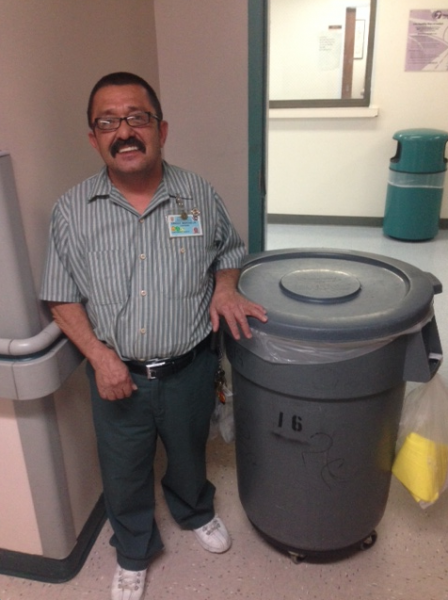Will A New South L.A. Hospital Mend Old Wounds?

Ernest Moreno shuffles across the floor of the Martin Luther King Jr. Multi-Service Ambulatory Care Center with his cleaning cart in tow. His head is down but his ears are open, as they have been for 19 years.
Moreno, called Ernie by his fellow staff members, has been working with the ambulatory center since it was the Martin Luther King Jr./ Charles Drew Medical Center.
The original hospital closed down in 2007 after severe shortcomings by doctors, nurses and administration tht injured and killed patients.
It has been almost eight years, but Moreno remembers the old King/Drew as if it were yesterday.
“The pharmacy is down there,” Moreno said pointing down the hall. “Everyone waits a really long time to receive their medicine, it was the same at the old hospital. The police would come a lot to break things up because people would get so angry waiting in line.”
Moreno remembers unruly patients as one of the more prevalent issues hospital staff faced. However, it was unattended patients that played a large role in the hospital’s closure and its bad reputation.
Reports of people dying due to a lack of care circulated around the neighborhood and stigmatized the hospital.
Now a Teach For America biology teacher, Elizabeth Adabale knows all about the previous hospital's awful reputation.
While recalling her days at the King Drew Magnet High School, Adabale speaks feverently of her own personal encounters with the hospital that became known as "Killer King."
“It was sort of this hospital that no one really used because we all knew it was run down,” said Adabale. “There was also this scandal going around school that a woman died in the lobby because no one would see her.”
Adabale graduated from King Drew Medical Magnet High School in 2009. The high school, which puts an emphasis on hands on medical experiences, is across the street from the ambulatory care center.
The magnet school offers a program that allows students to volunteer in local hospitals during the academic year.
As the image of the Martin Luther King Jr./ Charles Drew Medical Center publicly declined, it received less and less students from the magnet school's hospital program. The fear of working within a rotting hospital, outweighed the accessibility of its location for most of the students. Including Adabale.
“By the time I was in the program, they were limiting the amount of people that worked there [King/Drew],” Adabale said. “I chose to work in the emergency unit of the VA West Los Angeles Healthcare Center.”
Adabale was able to work at and attend a separate hospital because she lived in Carson, but Watt’s residents didn’t have that luxury.
Consequently, long time residents of the Watts-Willowbrook community are hopeful that the new MLK Community Hospital will offer them the healthcare luxuries that they lacked with the original medical center.
A local teen, 18, sits in the waiting room of the current ambulatory center and openly recalls her mother’s personal ordeal at the King/Drew hospital.
“I was born in this hospital, but growing up, my mom never brought me here,” the Watts resident said. “She used to come here, but there were a lot of complaints of bad emergency room service so she refused to take us.”

However, she knows the ambulatory care center quite well and is pleased with the improved quality.
“From what my mom told me, the service has gotten a lot better,” she said. “We’ve been here three times now because my mom is getting her surgery. I’ve spoken to the doctors, they all seem nice.”
The young women requested to stay annonymous.
Custodian Ernie Moreno agrees with her view of the new hospital staff, he thinks the incoming employees are friendlier and more effective.
“There are a lot of new faces,” Moreno said cracking a big smile. “A lot of changes are being made now, the new administration is really taking care of a lot of business.”
Moreno kindly welcomes the new authority in place. He was not so friendly when speaking about the last administration.
The infamous story of Edith Isabel Rodriguez' death in the lobby that spread throughout Elizabeth Adabale’s high school, and news stations state-wide, went deeper for the staff than most outsiders were aware.
“A woman fainted and the house keeper was mopping around her and noticed that she was dying. Later they tried to blame him, but it wasn’t his fault,” Moreno said.
After the death, janitorial workers feared that they too could share the blame for the medical shortcomings of the hospital.
For Moreno, the new state of the art facility and an equally refreshing medical team help keep those worries at bay. He is also looking forward to the upcoming improvements, like heightened security.
“Now it’s more well protected,” Moreno said. “Doctors and people are safer."
Better safety, an amicable staff and a high tech interior are just a few of the things patients may look forward to in the Martin Luther King Jr. Community Hospital.
The new hospital is set to open in early 2015, given it receives all of its proper licenses.
It is expected to serve about 1.2 million residents in the South Los Angeles region, which includes Watts-Willowbrook, Inglewood, Lynwood and Compton.
After 7 years without a central hospital, emergency healthcare in the Watts neighborhood will finally be restored.
Reach Executive Proucer Christianna Wiggins here and follow her on twitter here.



